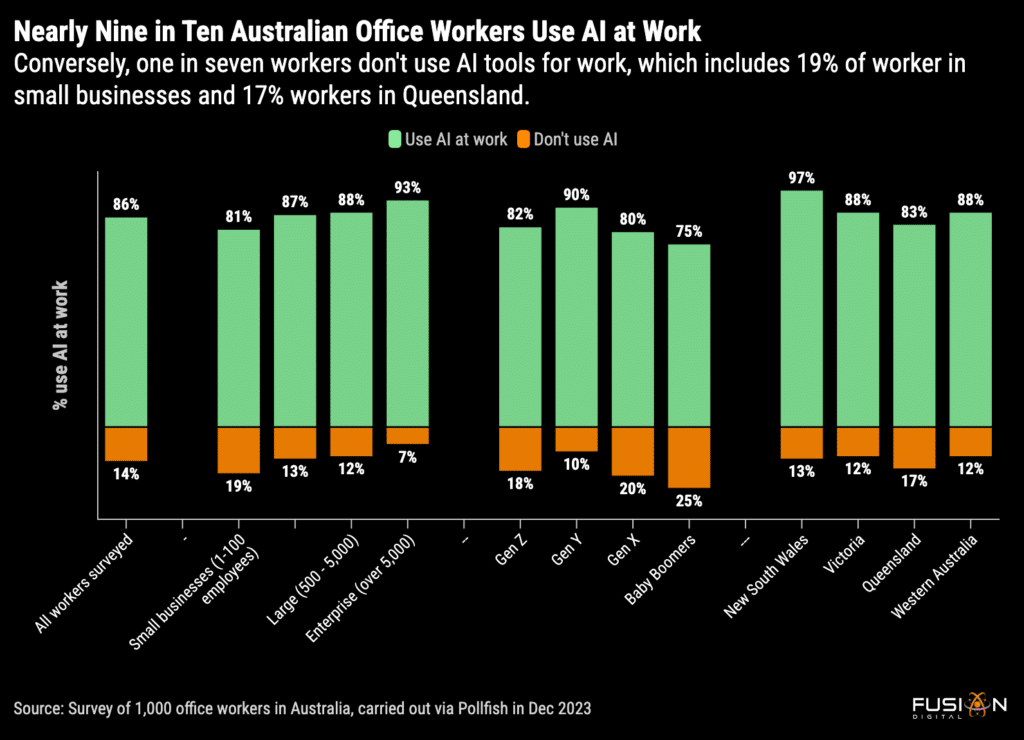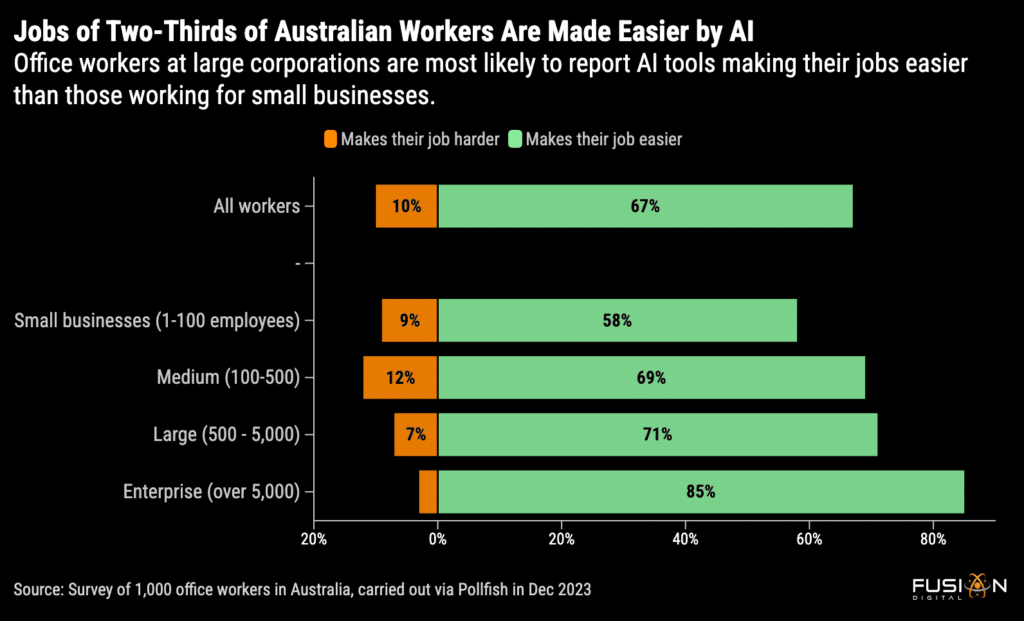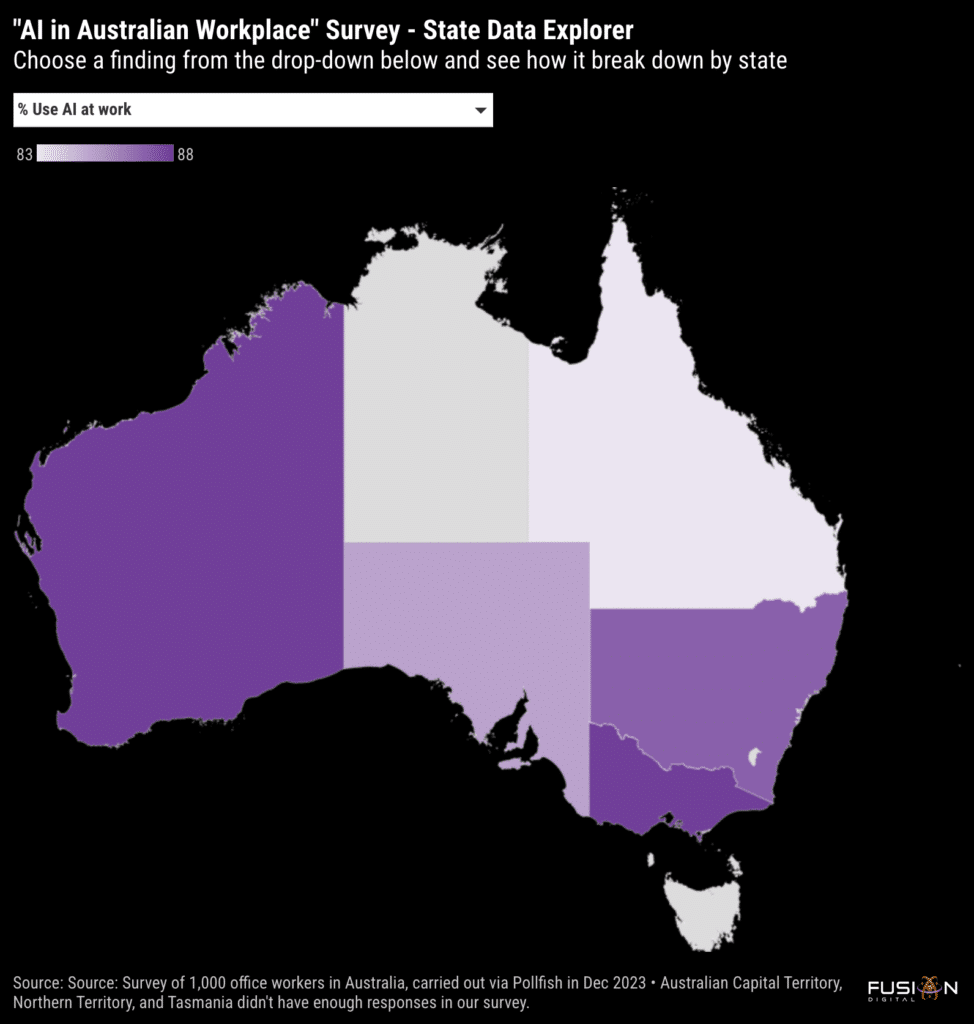To understand the extent of AI adoption and its impact on the Australian white-collar workforce, digital marketing agency Fusion Digital, conducted a comprehensive survey among Australian white collar workers from different sectors.
The survey aimed to uncover insights into AI usage patterns, perceptions, and its influence on productivity and job satisfaction.
In this article, we delve into the survey findings, shedding light on the current state of AI integration and its implications for the Australian workforce.
Key Findings
- 86% of white-collar workers in Australia use AI
- ChatGPT is by far the most popular AI tool with 72% of white-collar workers using it
- A typical Australian office worker spends 4.6 hours a week using AI tools
- One in five (21%) Australian office workers use AI in secret from their employer
- Four in ten Australian white-collar workers trust AI
- Two-thirds (66%) believe AI makes their jobs easier
- 40% of white-collar workers in Australia agree with Musk, that AI will positively impact society, others aren’t so sure
- 75% believe using AI saves them at least some time
- $60 per month is how much, on average, Australian office workers are prepared to spend on an AI tool or platform, provided it saves them time or makes their work easier.
- “I’m with Boomers on this one”: Gen Z Workers Sceptical About AI – Only 40% think we should trust AI and just 30% believe it generates correct and accurate answers
- In fact, in their attitudes towards AI, the youngest generation is much closer to Baby Boomers (aged 58+)
- A Self-Fulfilling Prophecy: The More Workers Use AI, The More They Trust It
- Diminishing returns: Sinking more time into AI doesn’t necessarily lead to greater time savings
- Using Both ChatGPT & Google’s Bard Results in Greatest Times Saving
- Despite being most widely used, ChatGPT users are most sceptical of its answers and AI in general
The Landscape of AI Adoption
The Extent of AI Usage
According to the survey results, a staggering 86% of white-collar workers in Australia reported using AI in their work.
Further analysis reveals that the majority of workers surveyed (55%) utilise AI tools on an occasional basis.
Curiously, almost as many report using it rarely (16.1%) as those who use it all the time (15.7%).

And yet, roughly one in seven (14%) workers have never used AI tools. This includes 19% of those working for small businesses (1-100 employees) and 21% of workers in Queensland.
ChatGPT Leads the AI Landscape
Among the various AI tools available, ChatGPT emerged as the dominant player in the Australian white-collar workforce. A significant 72% of respondents reported using ChatGPT, while Google’s Bard came in second with only 39% of respondents mentioning it.
Curiously, almost one in five (17%) workers don’t use any kind of AI tools.
Despite being most widely used, ChatGPT users are most sceptical of its answers and AI in general
Even though some 72% of Australian office workers use ChatGPT, only 52% of them believe that AI gives them accurate answers – the lowest of AI tools profiled in our survey.
As many as at 76% of Claude users believe AI-generated answers are correct and accurate, as do 67% of those who use Google’s Bard.
Similarly, just 57% of ChatGPT users are inclined to trust AI in general, compared to 81% of those who use Claude and 72% who use Google’s Bard.
| AI Tool Used* | % believe AI answers are accurate | % think we should trust AI |
| ChatGPT | 52% | 57% |
| Google’s Bard | 67% | 72% |
| Claude | 76% | 81% |
| Midjourney | 70% | 71% |
*Used alone or in conjunction with others
The Impact of AI on Work Habits
AI Saves 4.6 Hours Per Week for the Average Australian Office Worker
The survey findings indicate that a typical Australian office worker spends an average of 4.6 hours per week utilizing AI tools.
This average increases to 5.4 hours for those who use AI tools occasionally or regularly.
Among the respondents, 53% reported using AI tools for up to 5 hours per week, while a third (32%) spent more than 5 hours per week on AI-related tasks.
Notably, employees of larger companies (over 5000 employees) were found to be the most proactive users of AI, spending an average of 6.7 hours per week on AI tools, compared to approximately 3 hours per week for employees of small businesses (1-100 employees).
Notably, employees of larger companies (over 5000 employees) were found to be the most proactive users of AI, spending an average of 6.7 hours per week on AI tools, compared to approximately 3 hours per week for employees of small businesses (1-100 employees).
Using Both ChatGPT & Google’s Bard Results in Greatest Times Saving
It would appear the best way to extract the most value out of AI tools is to use them in combination.
Just 19% of workers who only use ChatGPT said it saves them 5 or more hours of work per week. Curiously, 44% of those who solely use Google’s Bard reported similar time savings.
However, it is workers who use both ChatGPT and Bard that are most likely to see the greatest time savings, as 69% of those making use of both AI tools said they save 5+ hours of work per week.
1 in 5 Australian Professionals Use AI Secretly at Work
The study also uncovered an intriguing trend – 21% of Australian white collar workers admit to using AI tools secretly at work without their employer’s knowledge.
While nearly two-thirds (63%) are transparent about their AI use, this finding reveals many professionals take matters into their own hands, implementing AI without oversight.
Additionally, the survey found transparency around AI increases with company size. 83% of employees at large enterprises (over 5,000 staff) don’t hide their AI use from employers, compared to just 57% at small businesses.
As AI tools become more powerful and accessible, companies may need clear policies around responsible AI use. For now, many professionals take an “ask forgiveness, not permission” approach in order to reap the benefits.
Perceptions of AI in the Workplace
Australian Professionals Split on Whether to Trust AI
When it comes to trusting AI tools, Australian white collar workers appear divided.
44% of respondents believe the AI they use generates accurate and correct answers.

However, an equal percentage are more sceptical – either believing AI is only sometimes accurate (38%) or that it does not produce correct answers at all (8%).
Likewise, attitudes towards generally trusting AI are mixed. A slim majority of 53% are wary of trusting AI or unsure if we should. The remaining 48% believe AI can be trusted.
There is also a correlation between AI use and trust. The more hours spent using AI weekly, the more likely workers are to trust it and believe it generates accurate outputs.
For example, of those using AI for less than one hour per week:
- Only 25% think we should trust AI
- Just 34% believe it has a positive impact
- And only 64% feel it gives correct and accurate answers
Whereas for workers using AI 10+ hours per week:
- 78% believe we should trust AI
- 76% think it has a positive impact
- And 78% believe AI gives correct and accurate answers
So while outlooks on trusting AI vary, hands-on experience seems to make professionals more trusting of – and reliant on – artificial intelligence over time.
| AI Use Band | Believe we should trust AI | Think it will have a positive impact | Believe AI gives correct and accurate answers |
| Less than 1 hour | 25% | 18% | 19% |
| 1-2 hours a week | 34% | 31% | 36% |
| 3-5 hours a week | 64% | 48% | 56% |
| 5-10 hours a week | 76% | 65% | 67% |
| 10+ hours a week | 78% | 71% | 77% |
Generational Divide: Gen Z Most Wary of AI (Agree With Boomers)
The survey revealed intriguing generational differences in how Australian professionals perceive AI tools.
Millennials (aged 27-42) appear most enthusiastic about AI:
- 49% believe it will have a positive societal impact
- 55% say we should trust AI
- 73% think it makes their job easier
- 51% believe AI generates correct answers
In contrast, Gen Z (aged 18-26) seem more skeptical:
- Only 40% think we should trust AI
- Just 30% believe it generates correct answers
In fact, Gen Z attitudes align more closely with Baby Boomers (aged 58+):
- 42% of Gen Z believe AI will have a negative impact (50% for Boomers)
- 16% think it makes their work harder (15% for Boomers)
- 10% believe AI creates more work than it saves (10% for Boomers)
So while most generations have embraced AI in the workforce, Gen Z stands out as the most cautious, disproving the assumption that younger digital natives would be most enthused by AI.
AI Viewed as an Enabler by Australian Professionals
Despite some doubts around accuracy and trust, most Australian white collar professionals find AI makes their job easier.
Overall, two thirds (66%) believe AI tools make their work easier. This perception increases along with company size.
For example, 85% of workers at major enterprises (over 5,000 employees) say AI makes their job easier. That drops to 68% at mid-sized firms and further declines to 58% among small business employees.

Conversely, only 10% feel AI makes their work harder overall.
However, the belief that AI makes jobs easier decreases with company size, with 68% of medium-sized company employees (101-500 employees) and 58% of small business employees sharing the same sentiment.
A small percentage of respondents (10%) believed that AI makes their jobs harder.
75% believe using AI saves them at least some time
In terms of time savings, workers estimate using AI saves them 6.2 hours per week on average. One in three (35%) say it saves them 5 or more hours weekly.
On the other hand, around a quarter (25%) say they only save up to 2 hours per week.
However, the data also reveals diminishing returns. More time spent using AI doesn’t necessarily result in greater time savings. Just 15% of professionals save more time than they spend using AI tools.
Nonetheless, for now most Australian white collar workers view AI as an enabler, making work easier, faster and more efficient. But there are certainly limits on just how much time it can save.
| Time spent using AI tools | % save at least as much | % save more time than spend | % spend more time than save |
| Less than 1 hour | 66% | 16% | … |
| 1-2 hours a week | 76% | 13% | 31% |
| 3-5 hours a week | 75% | 14% | 49% |
| 5-10 hours a week | 63% | 14% | 32% |
| 10+ hours a week | 47% | … | 46% |
A Willingness to Pay for Productivity
Given the generally positive stance towards AI, how much are Australian professionals willing to pay for AI tools that enhance their productivity?
According to the survey, the average worker would pay $60 per month for an AI solution that saves them time or makes their work easier.
40% would prefer to keep their AI tool budget under $50 per month. However, 38% are open to paying $50 or more monthly for AI tools that simplify their work.
This indicates a sizable number of professionals value AI’s productivity benefits enough to pay a monthly fee comparable to other software services.
For employers, promoting vetted AI tools on an approved software allowance could drive adoption. With the average worker willing to invest their own money, company-provided AI tools would likely see high uptake.

Future Implications and Conclusion
40% of white-collar workers in Australia agree with Musk
A significant portion (40%) of the Australian white-collar workforce agrees with Elon Musk’s assertion that AI will have a positive impact on society.
However, half of the respondents either hold the opposite view (33%) or are unsure (11%) about the impact of AI on society.
Conclusion: AI’s Expanding Role
The findings from this survey provide a snapshot into how deeply AI has permeated the professional lives of Australian office workers in as little as 12 months.
While some generational and organizational divides exist, the majority of professionals already rely on AI to various degrees. Expectations are that usage and dependence will continue rising steadily in the years ahead.
As this happens, companies will need to implement appropriate governance including AI ethics policies. Companies should also be thinking about investing in AI training and infrastructure to stay competitive and ensure employees are equipped with the necessary skills to leverage AI effectively.
For workers, the path ahead will require new skills to capitalise on AI as an augmenting force. But if handled strategically, Australia’s white collar professionals could be poised to benefit from the AI age.
Methodology and Survey Details
Survey Methodology
The data presented in this report was collected through a survey carried out by by Fusion Digital in December 2023 via Pollfish. The survey targeted white-collar workers across various industries in Australia.
A sample size of 1000 respondents was obtained, ensuring a diverse representation of professionals from different sectors, states, demographics, seniority and company sizes.
The survey was conducted online and consisted of a series of questions related to AI usage, perceptions, and its impact on the workplace.
Limitations
While every effort was made to ensure the accuracy and reliability of the survey results, there are certain limitations to consider.
The survey relied on self-reported data, which may be subject to biases or inaccuracies.
Additionally, the sample size, while representative, may not capture the entire population of white-collar workers in Australia.
Nevertheless, the survey provides valuable insights into the prevailing trends and perceptions regarding AI use in the workforce.
Usage Rights
This data was collected and provided by Fusion Digital via Pollfish. You are free to use the charts, stats, quotes and data from this article, but Fusion Digital must be credited as the source in any third party coverage or usage of the insights.




